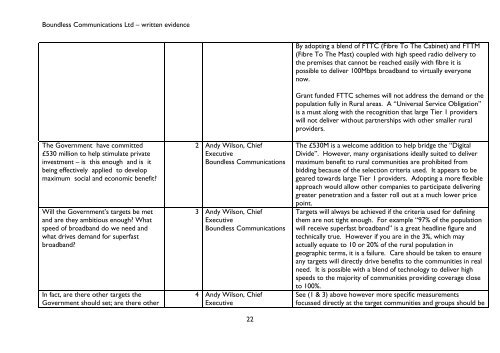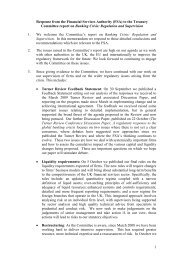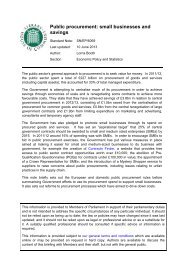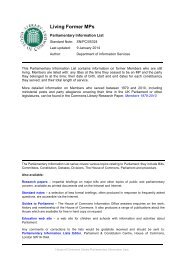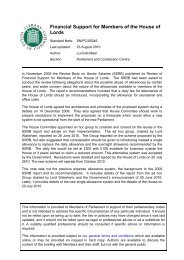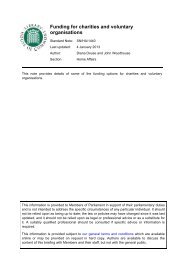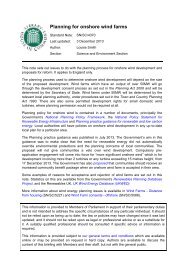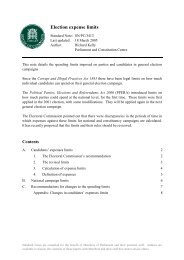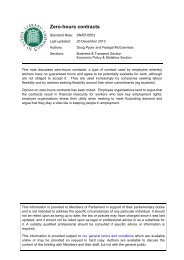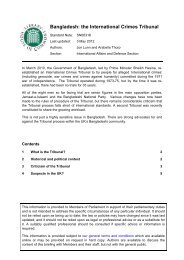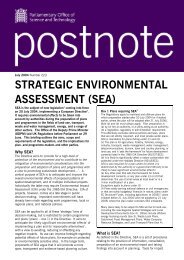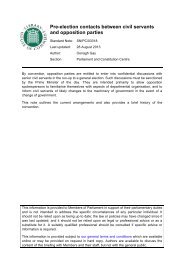- Page 1 and 2: Select Committee on Communications
- Page 3 and 4: NICC Ethernet Working Group - writt
- Page 5 and 6: Aardman Animations - written eviden
- Page 7 and 8: Aardman Animations - written eviden
- Page 9 and 10: Arqiva - written evidence About Arq
- Page 11 and 12: Arqiva - written evidence licences.
- Page 13 and 14: Arqiva - written evidence 17. In ad
- Page 15 and 16: Arqiva - written evidence broadband
- Page 17 and 18: Avanti Communications - written evi
- Page 19 and 20: Avanti Communications - written evi
- Page 21: Boundless Communications Ltd - writ
- Page 25 and 26: British Film Institute - written ev
- Page 27 and 28: British Film Institute - written ev
- Page 29 and 30: British Recorded Music (BPI) - writ
- Page 31 and 32: British Recorded Music (BPI) - writ
- Page 33 and 34: British Recorded Music (BPI) - writ
- Page 35 and 36: British Recorded Music (BPI) - writ
- Page 37 and 38: British Recorded Music (BPI) - writ
- Page 39 and 40: Broadband Stakeholder Group (BSG) -
- Page 41 and 42: Broadband Stakeholder Group (BSG) -
- Page 43 and 44: Broadband Stakeholder Group (BSG) -
- Page 45 and 46: Broadband Stakeholder Group (BSG) -
- Page 47 and 48: Broadband Stakeholder Group (BSG) -
- Page 49 and 50: Broadband Stakeholder Group - oral
- Page 51 and 52: Broadband Stakeholder Group - oral
- Page 53 and 54: Broadband Stakeholder Group - oral
- Page 55 and 56: Broadband Stakeholder Group - oral
- Page 57 and 58: Broadband Stakeholder Group - oral
- Page 59 and 60: Broadband Stakeholder Group - oral
- Page 61 and 62: Broadband Stakeholder Group - oral
- Page 63 and 64: Broadband Stakeholder Group - oral
- Page 65 and 66: Broadband Stakeholder Group - oral
- Page 67 and 68: Broadband Stakeholder Group - oral
- Page 69 and 70: Broadway Partners - written evidenc
- Page 71 and 72: Broadway Partners - written evidenc
- Page 73 and 74:
Broadway Partners - written evidenc
- Page 75 and 76:
BT Group plc - written evidence 6.
- Page 77 and 78:
BT Group plc - written evidence bro
- Page 79 and 80:
BT Group plc - written evidence 26.
- Page 81 and 82:
BT Group plc - written evidence wou
- Page 83 and 84:
BT Group plc - written evidence 46.
- Page 85 and 86:
BT Group plc - written evidence 55.
- Page 87 and 88:
BT Group plc - oral evidence (QQ 46
- Page 89 and 90:
BT Group plc - oral evidence (QQ 46
- Page 91 and 92:
BT Group plc - oral evidence (QQ 46
- Page 93 and 94:
BT Group plc - oral evidence (QQ 46
- Page 95 and 96:
BT Group plc - oral evidence (QQ 46
- Page 97 and 98:
BT Group plc - oral evidence (QQ 46
- Page 99 and 100:
BT Group plc - oral evidence (QQ 46
- Page 101 and 102:
BT Group plc - oral evidence (QQ 46
- Page 103 and 104:
BT Group plc - oral evidence (QQ 46
- Page 105 and 106:
BT Group plc - oral evidence (QQ 46
- Page 107 and 108:
BT Group plc - oral evidence (QQ 46
- Page 109 and 110:
BT Group plc - oral evidence (QQ 46
- Page 111 and 112:
Buckinghamshire Business First - wr
- Page 113 and 114:
Buckinghamshire Business First - wr
- Page 115 and 116:
Professor Peter Buneman - written e
- Page 117 and 118:
Francesco Caio - oral evidence (QQ
- Page 119 and 120:
Francesco Caio - oral evidence (QQ
- Page 121 and 122:
Francesco Caio - oral evidence (QQ
- Page 123 and 124:
Francesco Caio - oral evidence (QQ
- Page 125 and 126:
Francesco Caio - oral evidence (QQ
- Page 127 and 128:
Click4Internet - written evidence C
- Page 129 and 130:
Click4Internet - written evidence W
- Page 131 and 132:
The Coalition for a Digital Economy
- Page 133 and 134:
The Coalition for a Digital Economy
- Page 135 and 136:
Dr Peter Cochrane OBE - oral eviden
- Page 137 and 138:
Dr Peter Cochrane OBE - oral eviden
- Page 139 and 140:
Dr Peter Cochrane OBE - oral eviden
- Page 141 and 142:
Dr Peter Cochrane OBE - oral eviden
- Page 143 and 144:
Dr Peter Cochrane OBE - oral eviden
- Page 145 and 146:
Dr Peter Cochrane OBE - oral eviden
- Page 147 and 148:
Dr Peter Cochrane OBE - oral eviden
- Page 149 and 150:
Dr Peter Cochrane OBE - oral eviden
- Page 151 and 152:
Communication Workers Union (CWU) -
- Page 153 and 154:
Communication Workers Union (CWU) -
- Page 155 and 156:
Communication Workers Union (CWU) -
- Page 157 and 158:
Communications Chambers and FTTH Co
- Page 159 and 160:
Communications Chambers and FTTH Co
- Page 161 and 162:
Communications Chambers and FTTH Co
- Page 163 and 164:
Communications Chambers and FTTH Co
- Page 165 and 166:
Communications Chambers and FTTH Co
- Page 167 and 168:
Communications Chambers and FTTH Co
- Page 169 and 170:
Communications Chambers and FTTH Co
- Page 171 and 172:
Communications Chambers and FTTH Co
- Page 173 and 174:
Communications Chambers and FTTH Co
- Page 175 and 176:
Communications Chambers and FTTH Co
- Page 177 and 178:
Communications Chambers and FTTH Co
- Page 179 and 180:
Communications Chambers and FTTH Co
- Page 181 and 182:
Communications Chambers and FTTH Co
- Page 183 and 184:
Communications Chambers and FTTH Co
- Page 185 and 186:
Communications Chambers and FTTH Co
- Page 187 and 188:
Communications Chambers and FTTH Co
- Page 189 and 190:
Communications Chambers and FTTH Co
- Page 191 and 192:
Communications Chambers and FTTH Co
- Page 193 and 194:
Communications Chambers and FTTH Co
- Page 195 and 196:
Communications Chambers and FTTH Co
- Page 197 and 198:
Communications Consumer Panel - wri
- Page 199 and 200:
Communications Consumer Panel - wri
- Page 201 and 202:
Communications Consumer Panel - wri
- Page 203 and 204:
Communications Consumer Panel - wri
- Page 205 and 206:
Communications Consumer Panel - wri
- Page 207 and 208:
Communications Consumer Panel - wri
- Page 209 and 210:
Communications Consumer Panel - wri
- Page 211 and 212:
David Cooper CEng MIET - written ev
- Page 213 and 214:
David Cooper CEng MIET - written ev
- Page 215 and 216:
David Cooper CEng MIET - written ev
- Page 217 and 218:
Cotswold Community Networks Ltd - w
- Page 219 and 220:
Cotswold Community Networks Ltd - w
- Page 221 and 222:
The Country Land & Business Associa
- Page 223 and 224:
The Country Land & Business Associa
- Page 225 and 226:
The Country Land & Business Associa
- Page 227 and 228:
Creative Coalition Campaign - writt
- Page 229 and 230:
Creative Coalition Campaign - writt
- Page 231 and 232:
Cumbria County Council - written ev
- Page 233 and 234:
Cumbria County Council - written ev
- Page 235 and 236:
Cumbria County Council - written ev
- Page 237 and 238:
David Hall Systems Ltd - written ev
- Page 239 and 240:
David Hall Systems Ltd - written ev
- Page 241 and 242:
Department for Culture, Media and S
- Page 243 and 244:
Department for Culture, Media and S
- Page 245 and 246:
Department for Culture, Media and S
- Page 247 and 248:
Department for Culture, Media and S
- Page 249 and 250:
Department for Culture, Media and S
- Page 251 and 252:
Department for Culture, Media and S
- Page 253 and 254:
Department for Culture, Media and S
- Page 255 and 256:
Department for Culture, Media and S
- Page 257 and 258:
Department for Culture, Media and S
- Page 259 and 260:
Department for Culture, Media and S
- Page 261 and 262:
Department for Culture, Media and S
- Page 263 and 264:
Department for Culture, Media and S
- Page 265 and 266:
Department for Culture, Media and S
- Page 267 and 268:
Department for Culture, Media and S
- Page 269 and 270:
Department for Culture, Media and S
- Page 271 and 272:
Digital Outreach - written evidence
- Page 273 and 274:
Digital Outreach - written evidence
- Page 275 and 276:
Directors UK - written evidence Dir
- Page 277 and 278:
Directors UK - written evidence 8.
- Page 279 and 280:
Directors UK - written evidence sho
- Page 281 and 282:
Directors UK - written evidence wor
- Page 283 and 284:
Everything Everywhere - written evi
- Page 285 and 286:
Everything Everywhere - written evi
- Page 287 and 288:
Everything Everywhere - supplementa
- Page 289 and 290:
Federation of Communications Servic
- Page 291 and 292:
Federation of Communications Servic
- Page 293 and 294:
Federation of Small Businesses - wr
- Page 295 and 296:
Federation of Small Businesses - wr
- Page 297 and 298:
Fibre GarDen (the Garsdale & Dentda
- Page 299 and 300:
Fibre GarDen (the Garsdale & Dentda
- Page 301 and 302:
Fibre GarDen (the Garsdale & Dentda
- Page 303 and 304:
Film Distributors Association - wri
- Page 305 and 306:
Film Distributors Association - wri
- Page 307 and 308:
FTTH Council Europe - written evide
- Page 309 and 310:
FTTH Council Europe - written evide
- Page 311 and 312:
FTTH Council Europe - written evide
- Page 313 and 314:
FTTH Council Europe and Communicati
- Page 315 and 316:
Fujitsu - written evidence Issues w
- Page 317 and 318:
Geo Networks Limited - written evid
- Page 319 and 320:
Dr Tehmina Goskar - written evidenc
- Page 321 and 322:
GreySky Consulting - written eviden
- Page 323 and 324:
GreySky Consulting - written eviden
- Page 325 and 326:
GreySky Consulting - written eviden
- Page 327 and 328:
Peter Griffin - written evidence 6.
- Page 329 and 330:
Peter Griffin - written evidence 20
- Page 331 and 332:
Groupe Intellex - written evidence
- Page 333 and 334:
Groupe Intellex - written evidence
- Page 335 and 336:
Huawei - written evidence Huawei -
- Page 337 and 338:
Huawei - written evidence Y axis: P
- Page 339 and 340:
Huawei - written evidence Question
- Page 341 and 342:
Huawei - written evidence Greater e
- Page 343 and 344:
Huawei - written evidence Additiona
- Page 345 and 346:
Huawei - written evidence Question
- Page 347 and 348:
Huawei - written evidence meetings,
- Page 349 and 350:
Huawei - written evidence Diagram -
- Page 351 and 352:
Huawei - written evidence We should
- Page 353 and 354:
Huawei - written evidence The flexi
- Page 355 and 356:
Huawei - written evidence How will
- Page 357 and 358:
Huawei - written evidence The achie
- Page 359 and 360:
Huawei - written evidence Question
- Page 361 and 362:
Huawei - written evidence Question
- Page 363 and 364:
Huawei - written evidence Question
- Page 365 and 366:
Huawei - written evidence a) How to
- Page 367 and 368:
Huawei - written evidence Question
- Page 369 and 370:
Huawei - written evidence Additiona
- Page 371 and 372:
Huawei - written evidence The growt
- Page 373 and 374:
Huawei - written evidence Additiona
- Page 375 and 376:
Huawei - written evidence Additiona
- Page 377 and 378:
The Independent Networks Cooperativ
- Page 379 and 380:
The Independent Networks Cooperativ
- Page 381 and 382:
The Independent Networks Cooperativ
- Page 383 and 384:
KCOM Group PLC - written evidence K
- Page 385 and 386:
KCOM Group PLC - written evidence h
- Page 387 and 388:
Robert Kenny - written evidence Rob
- Page 389 and 390:
Robert Kenny - written evidence dem
- Page 391 and 392:
Robert Kenny - written evidence 23.
- Page 393 and 394:
Robert Kenny - written evidence 86%
- Page 395 and 396:
Leire Exchange Broadband Action Gro
- Page 397 and 398:
Suvi Lindén - oral evidence (QQ 1-
- Page 399 and 400:
Suvi Lindén - oral evidence (QQ 1-
- Page 401 and 402:
Suvi Lindén - oral evidence (QQ 1-
- Page 403 and 404:
Suvi Lindén - oral evidence (QQ 1-
- Page 405 and 406:
Suvi Lindén - oral evidence (QQ 1-
- Page 407 and 408:
Suvi Lindén - oral evidence (QQ 1-
- Page 409 and 410:
Suvi Lindén - oral evidence (QQ 1-
- Page 411 and 412:
John McDonald - written evidence 3.
- Page 413 and 414:
John McDonald - written evidence 7.
- Page 415 and 416:
Miles Mandelson - written evidence
- Page 417 and 418:
Miles Mandelson - written evidence
- Page 419 and 420:
Miles Mandelson - written evidence
- Page 421 and 422:
Miles Mandelson - written evidence
- Page 423 and 424:
Miles Mandelson - written evidence
- Page 425 and 426:
Miles Mandelson - written evidence
- Page 427 and 428:
Miles Mandelson and Rory Stewart MP
- Page 429 and 430:
Miles Mandelson and Rory Stewart MP
- Page 431 and 432:
Miles Mandelson and Rory Stewart MP
- Page 433 and 434:
Miles Mandelson and Rory Stewart MP
- Page 435 and 436:
Miles Mandelson and Rory Stewart MP
- Page 437 and 438:
Miles Mandelson and Rory Stewart MP
- Page 439 and 440:
Miles Mandelson and Rory Stewart MP
- Page 441 and 442:
Miles Mandelson and Rory Stewart MP
- Page 443 and 444:
Miles Mandelson and Rory Stewart MP
- Page 445 and 446:
Dr Christopher T Marsden - written
- Page 447 and 448:
Dr Christopher T Marsden - written
- Page 449 and 450:
Dr Christopher T Marsden - written
- Page 451 and 452:
Dr Christopher T Marsden - written
- Page 453 and 454:
Dr Christopher T Marsden - written
- Page 455 and 456:
Dr Christopher T Marsden - written
- Page 457 and 458:
Microsoft - written evidence We bel
- Page 459 and 460:
Microsoft - written evidence Many o
- Page 461 and 462:
Microsoft - written evidence 5. How
- Page 463 and 464:
Microsoft - oral evidence (QQ 623-6
- Page 465 and 466:
Microsoft - oral evidence (QQ 623-6
- Page 467 and 468:
Microsoft - oral evidence (QQ 623-6
- Page 469 and 470:
Microsoft - oral evidence (QQ 623-6
- Page 471 and 472:
Microsoft - oral evidence (QQ 623-6
- Page 473 and 474:
Microsoft - oral evidence (QQ 623-6
- Page 475 and 476:
Microspec - written evidence 7. My
- Page 477 and 478:
Dr Catherine A. Middleton - written
- Page 479 and 480:
Dr Catherine A. Middleton - written
- Page 481 and 482:
Middleton Tyas Parish Council - wri
- Page 483 and 484:
Milton Keynes Council - written evi
- Page 485 and 486:
Tom Morris - written evidence Tom M
- Page 487 and 488:
Tom Morris - written evidence right
- Page 489 and 490:
Tom Morris - written evidence 13. H
- Page 491 and 492:
Motion Picture Association - writte
- Page 493 and 494:
Motion Picture Association - writte
- Page 495 and 496:
The National Education Network - wr
- Page 497 and 498:
The National Education Network - wr
- Page 499 and 500:
The National Education Network - wr
- Page 501 and 502:
The National Education Network - wr
- Page 503 and 504:
The National Education Network - wr
- Page 505 and 506:
The National Education Network - wr
- Page 507 and 508:
The National Education Network - wr
- Page 509 and 510:
The National Education Network - wr
- Page 511 and 512:
NG Events Ltd - written evidence vo
- Page 513 and 514:
NG Events Ltd - written evidence Fi
- Page 515 and 516:
NICC Ethernet Working Group - writt
- Page 517 and 518:
NICC Ethernet Working Group - writt
- Page 519 and 520:
Northern Fells Broadband (Cumbria)
- Page 521 and 522:
Northern Fells Broadband (Cumbria)
- Page 523 and 524:
Objective Designers - written evide
- Page 525 and 526:
Objective Designers - written evide
- Page 527 and 528:
Objective Designers - oral evidence
- Page 529 and 530:
Objective Designers - oral evidence
- Page 531 and 532:
Objective Designers - oral evidence
- Page 533 and 534:
Objective Designers - oral evidence
- Page 535 and 536:
Objective Designers - oral evidence
- Page 537 and 538:
Objective Designers - oral evidence
- Page 539 and 540:
Objective Designers - oral evidence
- Page 541 and 542:
Objective Designers - oral evidence
- Page 543 and 544:
Ofcom - written evidence Ofcom - wr
- Page 545 and 546:
Ofcom - written evidence superfast
- Page 547 and 548:
Ofcom - written evidence Figure 3:
- Page 549 and 550:
Ofcom - written evidence • Vodafo
- Page 551 and 552:
Ofcom - written evidence have both
- Page 553 and 554:
Ofcom - written evidence superfast
- Page 555 and 556:
Ofcom - written evidence from the e
- Page 557 and 558:
Ofcom - oral evidence (QQ 650-747)
- Page 559 and 560:
Ofcom - oral evidence (QQ 650-747)
- Page 561 and 562:
Ofcom - oral evidence (QQ 650-747)
- Page 563 and 564:
Ofcom - oral evidence (QQ 650-747)
- Page 565 and 566:
Ofcom - oral evidence (QQ 650-747)
- Page 567 and 568:
Ofcom - oral evidence (QQ 650-747)
- Page 569 and 570:
Ofcom - oral evidence (QQ 650-747)
- Page 571 and 572:
Ofcom - oral evidence (QQ 650-747)
- Page 573 and 574:
Ofcom - oral evidence (QQ 650-747)
- Page 575 and 576:
Ofcom - oral evidence (QQ 650-747)
- Page 577 and 578:
Ofcom - oral evidence (QQ 650-747)
- Page 579 and 580:
Ofcom - oral evidence (QQ 650-747)
- Page 581 and 582:
Chi Onwurah MP - oral evidence (QQ
- Page 583 and 584:
Chi Onwurah MP - oral evidence (QQ
- Page 585 and 586:
Chi Onwurah MP - oral evidence (QQ
- Page 587 and 588:
Chi Onwurah MP - oral evidence (QQ
- Page 589 and 590:
Chi Onwurah MP - oral evidence (QQ
- Page 591 and 592:
Chi Onwurah MP - supplementary writ
- Page 593 and 594:
Chi Onwurah MP - supplementary writ
- Page 595 and 596:
Parliamentary Office of Science and
- Page 597 and 598:
Parliamentary Office of Science and
- Page 599 and 600:
John Peart - written evidence b. Se
- Page 601 and 602:
Mike Phillips - written evidence un
- Page 603 and 604:
Simon Pike - written evidence Commi
- Page 605 and 606:
Simon Pike - written evidence Laten
- Page 607 and 608:
Simon Pike - written evidence Will
- Page 609 and 610:
Pitchup.com - written evidence 'Bro
- Page 611 and 612:
Prospect - written evidence organis
- Page 613 and 614:
Prospect - written evidence 13. Ofc
- Page 615 and 616:
Prospect - written evidence has occ
- Page 617 and 618:
Prospect - written evidence vast ma
- Page 619 and 620:
Prospect - written evidence the gro
- Page 621 and 622:
The Publishers Association - writte
- Page 623 and 624:
The Publishers Association - writte
- Page 625 and 626:
Steve Robertson - oral evidence (QQ
- Page 627 and 628:
Steve Robertson - oral evidence (QQ
- Page 629 and 630:
Steve Robertson - oral evidence (QQ
- Page 631 and 632:
Steve Robertson - oral evidence (QQ
- Page 633 and 634:
Steve Robertson - oral evidence (QQ
- Page 635 and 636:
Steve Robertson - oral evidence (QQ
- Page 637 and 638:
Steve Robertson - oral evidence (QQ
- Page 639 and 640:
Les Savill - written evidence Les S
- Page 641 and 642:
South West Internet CIC - written e
- Page 643 and 644:
SSE plc - written evidence SSE plc
- Page 645 and 646:
SSE plc - written evidence • Abil
- Page 647 and 648:
SSE plc - written evidence Appendix
- Page 649 and 650:
SSE plc - oral evidence (QQ 379-407
- Page 651 and 652:
SSE plc - oral evidence (QQ 379-407
- Page 653 and 654:
SSE plc - oral evidence (QQ 379-407
- Page 655 and 656:
SSE plc - oral evidence (QQ 379-407
- Page 657 and 658:
SSE plc - oral evidence (QQ 379-407
- Page 659 and 660:
SSE plc - oral evidence (QQ 379-407
- Page 661 and 662:
SSE plc - supplementary written evi
- Page 663 and 664:
SSE plc - supplementary written evi
- Page 665 and 666:
SSE plc - supplementary written evi
- Page 667 and 668:
SSE plc - supplementary written evi
- Page 669 and 670:
SSE plc - supplementary written evi
- Page 671 and 672:
Sunderland Software City - written
- Page 673 and 674:
TalkTalk Group - written evidence T
- Page 675 and 676:
TalkTalk Group - written evidence
- Page 677 and 678:
TalkTalk Group - written evidence 1
- Page 679 and 680:
TalkTalk Group - oral evidence (QQ
- Page 681 and 682:
TalkTalk Group - oral evidence (QQ
- Page 683 and 684:
TalkTalk Group - oral evidence (QQ
- Page 685 and 686:
TalkTalk Group - oral evidence (QQ
- Page 687 and 688:
TalkTalk Group - oral evidence (QQ
- Page 689 and 690:
TalkTalk Group - supplementary writ
- Page 691 and 692:
TalkTalk Group - further supplement
- Page 693 and 694:
Taxpayers’ Alliance - written evi
- Page 695 and 696:
Taxpayers’ Alliance - written evi
- Page 697 and 698:
Taxpayers’ Alliance - written evi
- Page 699 and 700:
Three - written evidence LTE Techno
- Page 701 and 702:
Three - written evidence 23. It als
- Page 703 and 704:
Three and Vodafone - oral evidence
- Page 705 and 706:
Three and Vodafone - oral evidence
- Page 707 and 708:
Three and Vodafone - oral evidence
- Page 709 and 710:
Three and Vodafone - oral evidence
- Page 711 and 712:
Three and Vodafone - oral evidence
- Page 713 and 714:
Three and Vodafone - oral evidence
- Page 715 and 716:
UCL Centre for Digital Humanities -
- Page 717 and 718:
Upper Deverills Broadband Action Gr
- Page 719 and 720:
Upper Deverills Broadband Action Gr
- Page 721 and 722:
Virgin Media - written evidence way
- Page 723 and 724:
Virgin Media - written evidence 30
- Page 725 and 726:
Virgin Media - written evidence of
- Page 727 and 728:
Virgin Media - written evidence 31
- Page 729 and 730:
Virgin Media - oral evidence (QQ 28
- Page 731 and 732:
Virgin Media - oral evidence (QQ 28
- Page 733 and 734:
Virgin Media - oral evidence (QQ 28
- Page 735 and 736:
Virgin Media - oral evidence (QQ 28
- Page 737 and 738:
Virgin Media - oral evidence (QQ 28
- Page 739 and 740:
Virgin Media - oral evidence (QQ 28
- Page 741 and 742:
Virgin Media - oral evidence (QQ 28
- Page 743 and 744:
Virgin Media - oral evidence (QQ 28
- Page 745 and 746:
Vodafone - written evidence network
- Page 747 and 748:
Vodafone - written evidence f) Ener
- Page 749 and 750:
Vtesse Networks - written evidence
- Page 751:
Wispa Limited - written evidence Q.


